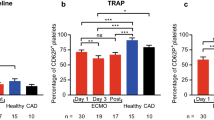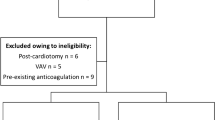Abstract
Objective: The enhanced generation of various chemical mediators is regarded as one of the mechanisms by which severe heart failure progresses to multiple organ failure. Platelet-activating factor is a phospholipid mediator which plays an important role in inflammatory reactions and circulatory shock. We studied the changes in platelet-activating factor levels in a canine heart failure model treated with a left ventricular assist device and hemofiltration, and assessed the effect of a protease inhibitor, nafamostat mesilate.Methods: Twenty dogs underwent multiple coronary ligations, and at 2 hours after the ligations they were maintained on left ventricular assist device support with continuous hemofiltration. The animals were divided into two groups: a nafamostat group (n = 10) that received nafamostat mesilate (2 mg/kg/hr), and a control group (n = 10) that received vehicle only.Results: The blood platelet-activating factor level, before coronary ligations, in the control and nafamostat groups was 2.3 ± 0.4 and 2.0 ± 0.7 ng/ml, respectively, and the coronary ligations had little effect on the platelet-activating factor. However, after the initiation of left ventricular assist device, the platelet-activating factor in the control group (5.6 ± 2.2) was significantly higher (p < 0.05) than that in the nafamostat group (1.1 ± 0.3). Nafamostat administration was also effective in controlling the increase in the blood lactate level. Hemofiltration did not change the platelet-activating factor.Conclusions: We concluded that platelet-activating factor may play a critical role in the development of severe heart failure with left ventricular assistance, and nafamostat administration is likely to be beneficial in such a critical condition by suppressing the platelet-activating factor level.
Similar content being viewed by others
References
Millar AB, Armstrong L, van der Linden J, Moat N, Ekroth R, Westwick J, et al. Cytokine production and hemofiltration in children undergoing cardiopulmonary bypass. Ann Thorac Surg 1993; 56: 1499–502.
Andreasson S, Göthberg S, Berggren H, Bengtsson A, Eriksson E, Risberg B. Hemofiltration modifies complement activation after extracorporeal circulation in infants. Ann Thorac Surg 1993; 56: 1515–7.
Janvier G, Baquey C, Roth C, Benillan N, Bélisle S, Hardy JF. Extracorporeal circulation, hemocompatibility, and biomaterials. Ann Thorac Surg 1996; 62: 1926–34.
Baufreton C, Kirsch M, Loisance DY. Measures to control blood activation during assisted circulation. Ann Thorac Surg 1998; 66: 1837–44.
Benveniste J, Chignard M. A role for PAF-acether (platelet-activating factor) in platelet-dependent vascular disease? Circulation 1985; 72: 713–7.
Stahl GL, Terashita Z, Lefer AM. Role of platelet activating factor in propagation of cardiac damage during myocardial ischemia. J Pharmacol Exp Ther 1988; 244: 898–904.
Maruyama M, Farber NE, Vercellotti GM, Jacob HS, Gross GJ. Evidence for a role of platelet activating factor in the pathogenesis of irreversible but not reversible myocardial injury after reperfusion in dogs. Am Heart J 1990; 120: 510–20.
Aoyama T, Ino Y, Ozeki M, Oda M, Sato T, Koshiyama Y, et al. Pharmacological studies of FUT-175, nafamostat mesilate. Inhibition of protease activity in in vitro and in vivo experiments. Jpn J Pharmacol 1984; 35: 203–27.
Prescott SM, Zimmerman GA, McIntyre TM. Human endothelial cells in culture produce platelet-activating factor (1-alkyl-2-acetyl-sn-glycero-3-phosphocholine) when stimulated with thrombin. Proc Natl Acad Sci USA 1984; 81: 3534–8.
Zimmerman GA, McIntyre TM, Prescott SM. Production of platelet-activating factor by human vascular endothelial cells: evidence for a requirement for specific agonists and modulation by prostacyclin. Circulation 1985; 72: 718–27.
Satoh K, Imaizumi T, Yoshida H, Hiramoto M, Takamatsu S. Increased levels of blood platelet-activating factor (PAF) and PAF-like lipids in patients with ischemic stroke. Acta Neurol Scand 1992; 85: 122–7.
Zehr KJ, Poston RS, Lee PC, Uthoff K, Kumar P, Cho PW, et al. Platelet activating factor inhibition reduces lung injury after cardiopulmonary bypass. Ann Thorac Surg 1995; 59: 328–35.
Takizawa S, Takahashi H, Hattori A, Nagayama R, Hanano M, Fuse I, et al. Effect of a new synthetic protease inhibitor FUT-175 (nafamostat mesilate) on blood coagulation, fibrinolysis and platelets. Saishin Igaku 1986; 41: 1645–51.
Imai T, Vercellotti GM, Meldow CF, Jacob HS, Weir EK. Pulmonary hypertension and edema induced by platelet-activating factor in isolated, perfused rat lungs are blocked by BN52021. J Lab Clin Med 1988; 111: 211–7.
Sawa Y, Schaper J, Roth M, Nagasawa K, Ballagi G, Bleese N, et al. Platelet-activating factor plays an important role in reperfusion injury in myocardium: efficacy of platelet-activating factor receptor antagonist (CV-3988) as compared with leukocyte-depleted reperfusion. J Thorac Cardiovasc Surg 1994; 108: 953–9.
Montrucchio G, Bergerone S, Bussolino F, Alloatti G, Silvestro L, Lupia E, et al. Streptokinase induces intravascular release of platelet-activating factor in patients with acute myocardial infarction and stimulates its synthesis by cultured human endothelial cells. Circulation 1993; 88: 1476–83.
Mueller HW, O’Flaherty JT, Wykle RL. Bio synthesis of platelet-activating factor in rabbit polymorphonuclear neutrophils. J Biol Chem 1983; 258: 6213–8.
Lorant DE, Patel KD, McIntyre TM, McEver RP, Prescott SM, Zimmerman GA. Coexpression of GMP-140 and PAF by endothelium stimulated by histamine or thrombin: a juxtacrine system for adhesion and activation of neutrophils. J Cell Biol 1991; 115: 223–34.
Suematsu M, Kurose I, Asako H, Miura S, Tsuchiya M.In vivo visualization of oxyradical-dependent photoemission during endothelium-granulocyte interaction in microvascular beds treated with platelet-activating factor. J Biochem 1989; 106: 355–60.
Suematsu M, Schmid-Schönbein GW, Chavez-Chavez RH, Yee TT, Tamatani T, Miyasaka M, et al.In vivo visualization of oxidative changes in microvessels during neutrophil activation. Am J Physiol 1993; 264: H881–91.
Smiley PL, Stremler KE, Prescott SM, Zimmerman GA, McIntyre TM. Oxidatively fragmented phosphatidylcholines activate human neutrophils through the receptor for platelet-activating factor. J Biol Chem 1991; 266: 1164–9.
Author information
Authors and Affiliations
Rights and permissions
About this article
Cite this article
Munakata, M., Ono, Y., Koyama, M. et al. Nafamostat mesilate modulates the release of platelet-activating factor during left ventricular assistance with hemofiltration in canine heart failure. Jpn J Thorac Caridovasc Surg 48, 106–111 (2000). https://doi.org/10.1007/BF03218100
Received:
Accepted:
Issue Date:
DOI: https://doi.org/10.1007/BF03218100




